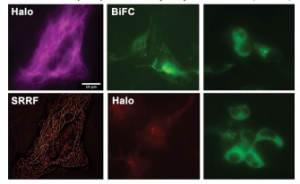
Ricardo Letra‐Vilela, Ricardo Quiteres, Fernanda Murtinheira, Alvaro Crevenna, Zach Hensel, and Federico Herrera
The glial fibrillary acidic protein (GFAP) is an intermediate filament widely used to identify and label astroglial cells, a very abundant and relevant glial cell type in the central nervous system. A major hurdle in studying its behavior and function arises from the fact that GFAP does not tolerate well the addition of protein tags to its termini. Here, we tagged human GFAP (hGFAP) with an enhanced green fluorescent protein (EGFP) for the first time, and substituted a previously reported EGFP tag on mouse GFAP (mGFAP) by a more versatile Halo Tag. Both versions of tagged GFAP were able to incorporate into the normal GFAP filamentous network in glioma cells, and Alexander disease-related mutations or pharmacological disruption of microtubules and actin filaments interfered with GFAP dynamics. These new tools could provide new fruitful venues for the study of GFAP oligomerization, aggregation and dynamics in living cells.
Doi: 10.1017/exp.2020.1.
Cited as: Letra-Vilela R, Quiteres R, Murtinheira F, Crevenna A, Hensel Z, Herrera F, Nevels M (2020). New tools for the visualization of glial fibrillary acidic protein in living cells. Experimental Results 1, E4; doi:10.1017/exp.2020.1.



